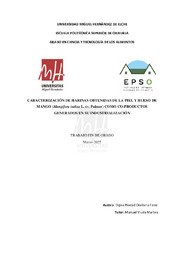Por favor, use este identificador para citar o enlazar este ítem:
https://hdl.handle.net/11000/36255Registro completo de metadatos
| Campo DC | Valor | Lengua/Idioma |
|---|---|---|
| dc.contributor.advisor | Viuda-Martos, Manuel | - |
| dc.contributor.author | Orellana Farez, Digna Piedad | - |
| dc.contributor.other | Departamentos de la UMH::Tecnología Agroalimentaria | es_ES |
| dc.date.accessioned | 2025-03-31T12:29:48Z | - |
| dc.date.available | 2025-03-31T12:29:48Z | - |
| dc.date.created | 2025-03 | - |
| dc.identifier.uri | https://hdl.handle.net/11000/36255 | - |
| dc.description.abstract | Los millones de toneladas de residuos vegetales (pieles y semillas) generadas en el procesamiento de industrialización de frutas es un gran problema. Por lo tanto, su apro-vechamiento para el desarrollo de potenciales subproductos es importante. El objetivo de este trabajo fue estudiar la composición química, las propiedades fisicoquímicas, tecno-funcionales y antioxidantes de harinas obtenidas a partir de piel y hueso de mango gene-rados en la industrialización del mango (Mangifera indica cv. Palmer), con la finalidad de evaluar su potencial uso como ingrediente funcional en el desarrollo de nuevos ali-mentos por parte de la industria alimentaria. Los resultados obtenidos presentan actividad antioxidante pudiendo ser empleadas en la elaboración de nuevos productos para aumentar su vida útil, Por otro lado, las muestras de harinas de piel y hueso de mango muestran un alto contenido en fibra dietética total. Asimismo, los valores de pH y actividad de agua de las muestras de harina de mango como la piel y el hueso son auto-estables por lo que serían un buen ingrediente en el desarrollo de nuevos alimentos. | es_ES |
| dc.description.abstract | The millions of tons of plant waste (peels and seeds) generated in the industrialization of fruit processing is a big problem. Therefore, its use for the development of potential by-products is important. The objective of this work was to study the chemical composition, physicochemical, techno-functional and antioxidant properties of flours obtained from mango peel and stone generated in the industrialization of mango (Mangifera indica cv. Palmer), with the purpose of evaluating its potential use as a functional ingredient in the development of new foods by the food industry. The results obtained show antioxidant activity and can be used in the production of new products to increase their useful life. On the other hand, the mango peel and stone flour samples show a high content of total dietary fiber. Likewise, the pH and water activity values of mango flour samples such as peel and stone are self-stable, so they would be a good ingredient in the development of new foods. | es_ES |
| dc.format | application/pdf | es_ES |
| dc.format.extent | 48 | es_ES |
| dc.language.iso | spa | es_ES |
| dc.publisher | Universidad Miguel Hernández de Elche | es_ES |
| dc.rights | info:eu-repo/semantics/openAccess | es_ES |
| dc.rights | Attribution-NonCommercial-NoDerivatives 4.0 Internacional | * |
| dc.rights.uri | http://creativecommons.org/licenses/by-nc-nd/4.0/ | * |
| dc.subject | Fibra dietética. | es_ES |
| dc.subject | Actividad antioxidante | es_ES |
| dc.title | Caracterización de harinas obtenidas de la piel y hueso de mango (Mangifera indica L. cv. Palmer.) como co-productos generados en su industrialización | es_ES |
| dc.type | info:eu-repo/semantics/bachelorThesis | es_ES |

Ver/Abrir:
TFG Orellana Farez, Digna.pdf
5,16 MB
Adobe PDF
Compartir:
 La licencia se describe como: Atribución-NonComercial-NoDerivada 4.0 Internacional.
La licencia se describe como: Atribución-NonComercial-NoDerivada 4.0 Internacional.
.png)